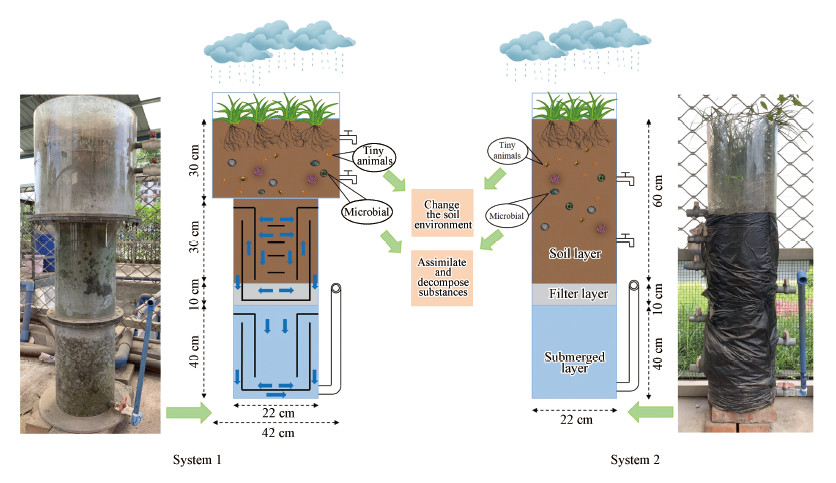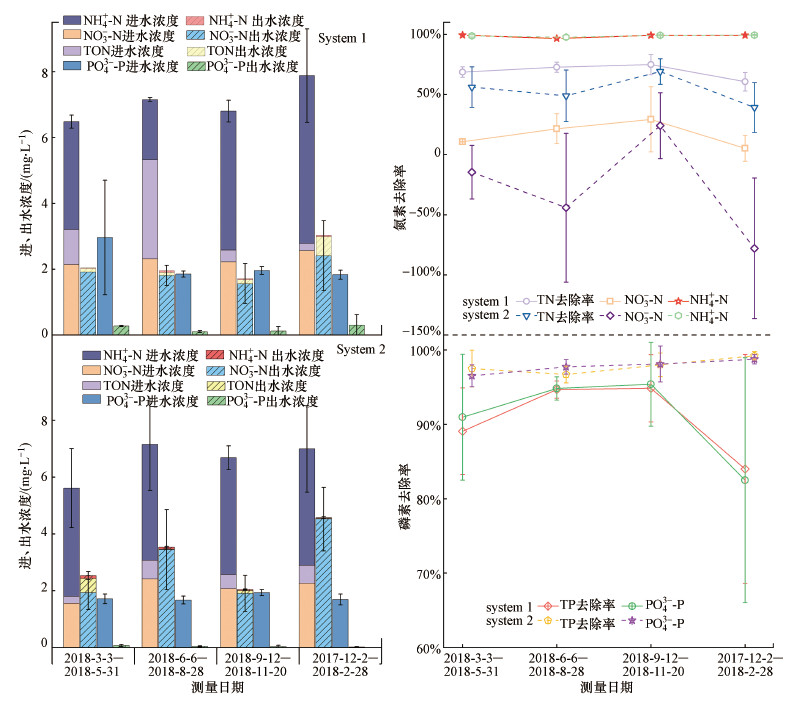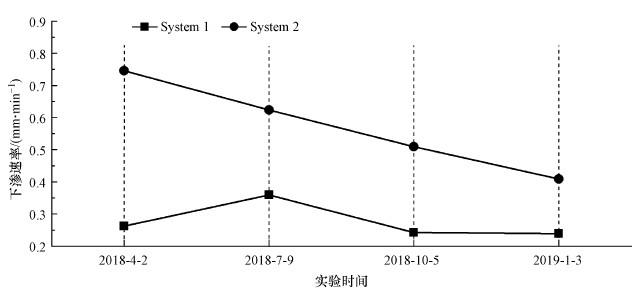2. 重庆文理学院化学与环境工程学院, 重庆 402160;
3. 环境材料与修复技术重庆市重点实验室, 重庆 402160;
4. 重庆市永川区生态环境局, 重庆 402160
2. College of Chemical and Environmental Engineering, Chongqing University of Arts and Sciences, Chongqing 402160;
3. Chongqing Key Laboratory of Environmental Material and Restoration Technology, Chongqing University of Arts and Sciences, Chongqing 402160;
4. Bureau of Ecology and Environment of Yongchuan District, Chongqing 402160
随着全球城市化进程的不断加快, 城区不透水地面迅速增加并逐渐成为城市内涝频发的主要原因之一.对此, 国际上提出了各种低影响开发措施(LID), 我国也在大力推行海绵城市建设(Hunt et al., 2008; Zhang et al., 2014; 王书敏等, 2015), 而生物滞留系统作为其中一项重要开发技术, 它以截污高效性、应用灵活性、功能多样性、成本低廉性的特征进入研究者视线.现有研究表明, 生物滞留系统可通过选种不同植物(Milandri et al., 2012; Liu et al., 2011; Geronimo et al., 2015), 添加基质改良剂(Stander et al., 2010; Ergas et al., 2010; Wilson et al., 2013), 设置淹没区(Brown et al., 2011; Zinger et al., 2013), 优化土壤层环境(Mehring et al., 2015)等方法, 达到提升径流中的营养物质(Hatt et al., 2009; Lucke et al., 2015; Waller et al., 2018)、多环芳烃(PAHs)(Diblasi et al., 2009; Kanaly et al., 2010; McIntyre et al., 2014)、重金属(Sun et al., 2007; Li et al., 2008; Trowsdale et al., 2011)等污染物去除率的效果.但同时也有研究指出, 生物滞留系统对径流营养元素的去除处于不稳定状态.Hunt等(2008)在研究中发现, 氨氮去除率最好, 为70.6%, 总氮去除率仅为32.1%, 而硝态氮甚至出现了淋洗现象, 为-4.8%;相似的是, 在Brown等(2011)建立的系统中, 氨氮去除率也最高(91.3%), 其次是总氮(79.6%), 但硝态氮去除率比Hunt的效果要好, 为44.7%;而Li等(2014)的研究中, 总氮、氨氮和硝态氮的去除率分别为-118.2%、53.2%、1.1%, 去除效果波动更大.相较于氮素, 系统对磷素的去除相对稳定.Hermawan等(2020), Song等(2019), 仇付国等(2017)研究发现, 生物滞留系统对总磷、磷酸盐的去除率均在80%以上.这是因为溶解磷主要依靠填料吸附和植物吸收去除(仇付国等, 2016), 而径流经过系统土壤层与填料充分接触, 所以以吸附为主的污染物去除效率更高.生物滞留系统净化后的雨水径流直接流入河流或补充地下水, 氮、磷元素的不稳定去除直接影响了周围水源水质.因此, 改进生物滞留系统使之稳定除污是当前面临的重要科学问题之一.
系统脱氮除磷效果与系统构造、降雨强度密切相关.Kanso等(2018)曾在研究中表示, 不同径流流态会改变系统土壤层的水力和物理性质.其中, 土壤透气性会影响系统中好氧、厌氧区的形成, 对脱氮微生物丰度、多样性与活性造成影响;含水率会对系统滞留水量造成直接影响;透水性、孔隙度会对系统下渗速率造成影响.因此, 径流流态会对系统脱氮除磷效果产生影响.目前针对径流流态对生物滞留系统脱氮除磷效果的研究较少, 王书敏等(2017)对防渗U型生物滞留系统的水文效应进行了研究, 发现U型设计可截留0.34 mm及以下或者降雨强度为0.054 mm·h-1以下的降雨径流, 但未对水质进行深入研究.Zhang等(2019a)构建并研究了上流式与混合式生物滞留系统脱氮除磷效果, 结果表明, 上流式与混流式生物滞留系统与传统系统相比, 虽然总磷去除率无明显差异, 但总氮去除率从传统式的17%±13%提升至上流式的41%±23%和混流式的31%±16%.针对径流流态对系统除污的影响, 仍需大量实验对其进行研究, 以提升系统运行效果.在实际情况中, 系统运行效果还受入渗速率影响, 而系统入渗速率随降雨强度的变化而波动.在朋四海等(2014)的研究中, 系统滤速为9.9 cm·h-1和14.5 cm·h-1, 总磷和氨氮去除率均为80%, 而低渗透系统对硝态氮的去除率高于高渗透系统(67.5%, 54.5%).综上所述, 研究生物滞留系统脱氮除磷效果中, 径流流态与降雨强度带来的工况变化是不可忽视的重要影响因素.
由于面源污染的特殊性, 径流污染物具有很强的难收集性和高污染性.为避免周围水体受到污染破坏, 提升生物滞留系统对径流的脱氮除磷效果十分重要.因此, 本文构建了折流式、直流式生物滞留系统, 深入研究了径流流态与降雨强度对系统脱氮除磷的影响, 结论可为海绵城市建设提供理论依据.
2 材料与方法(Materials and methods) 2.1 系统构建折流式系统与直流式系统同时采用砾石填充淹没区, 深度40 cm, 采用聚氯乙烯塑料管控制, 过渡层采用消防砂填充, 深度为10 cm, 介质土使用质量比为2∶8的土壤与细沙均匀混合填充, 深度为60 cm, 植物采用常青麦冬种植.系统构建如图 1所示, 直流式由直径22 cm圆柱型树脂玻璃管构成;折流式从上至下由直径为42 cm的树脂玻璃管构建前30 cm介质土层, 余下80 cm由直径22 cm树脂玻璃管构成, 并在过渡层、淹没区添加两套隔栏, 使径流形成横、纵交替流态.折流式系统以下简称系统1, 直流式系统简称系统2.
 |
| 图 1 生物滞留设施系统图 Fig. 1 Bioretention facility diagram |
实验统计近5年雨情及前期工作(王书敏等, 2016)发现, 重庆市雨量以中、小雨情为主, 通过设计生物滞留系统表面积与服务面积比为1∶50, 计算得出中、小雨情降雨强度分别为2.96、0.99 mm·min-1, 并将模拟径流污染浓度分为高、中、低3个等级, 见表 1.
| 表 1 径流污染物浓度 Table 1 Concentration of runoff pollutants |
实验使用蠕动泵(JIHPUMP BT-300EA)实现模拟降雨进水, 出水水样使用聚氯乙烯瓶分别在系统连续出水3~5 L时采集4~7次, 摇匀后立即使用LA-pH10(HACH, USA)测量水温和pH, 再参照《水和废水检测分析方法》使用德国CleverChem 380全自动间断化学分析仪测量TN、NH4+-N、NO3--N、TP和PO43--P浓度.TON通过式(1)计算得出.

|
(1) |
式中, TON为总有机氮浓度(mg·L-1);TN为总氮浓度(mg·L-1);NH4+为氨氮浓度(mg·L-1);NO3-为硝态氮浓度(mg·L-1).
土壤采集以等边三角形方式在生物滞留系统中选择取样点, 使用空心管取出土壤层40 cm土样, 混合均匀后, 依据HJ 634-2012(环境保护部, 2012)标准测量土壤NH4+-N和NO3--N;TN通过在土样中加入消解剂消解后, 取上清液进行紫外分光光度计检测得出.系统下渗速率通过保持5 cm水头高度(张万儒等, 1999), 待系统稳定出水后, 测量系统10~30 s出水量, 测定时间持续4~5 h以观察渗透性能的动态变化, 最终通过式(2)计算得出.

|
(2) |
式中, K为渗透系数(mm·min-1);Qn为n次渗透出水量(mL);tn为各次渗透事件间隔时间(min);L为介质土厚度(cm);S为实验柱横截面积(cm2);h为水头高度(cm).
实验共检测水质数据1472个, 其中折流式667个, 直流式805个;0.99 mm·min-1下, 折流式189个, 直流式160个;2.96 mm·min-1下, 折流式414个, 直流式425个, 如表 2所示.
| 表 2 研究期内生物滞留系统检测样品数量 Table 2 The number of bioretention systems detection data during the study period |
污染物去除效率使用式(3)计算, 并利用Origin 9.2制图.

|
(3) |
式中, RC(total)为去除率;Cout和Cin为出水和进水污染物浓度(mg·L-1);Jout和Jin为出水和进水的水通量(L);ttot为降雨事件的总时间(h).
3 结果与讨论(Results and discussion) 3.1 径流流态对系统脱氮除磷效果的影响径流中营养物质主要包含氮、磷两种元素.系统脱氮除磷效果如图 2所示, NH4+-N在系统1、2中平均去除率为98.71%±1.01%, 两个系统对径流NH4+-N去除稳定, 与Payne等(2014)、Brown等(2011)、Chen等(2013)在研究中得出的结论相同.这是因为NH4+-N依托与土壤不同的异种电荷, 大量吸附于土壤层后, 硝化细菌和植物根系快速转化、吸收NH4+-N, 使得系统拥有较高的NH4+-N去除效果.TON在系统1中, 除冬季淋洗外(-163.64%), 其余季节平均去除率为84.43%, 而在系统2中, 除春季淋洗外(-100.00%), 其余季节平均去除率为91.27%.TON淋洗的原因可能与植物生长有关, 因系统1拥有多个淹没区, 储水能力更强, 移栽植物更快在系统中稳定, 而植物吸收与释放TON是动态平衡过程, 所以系统2淋洗时间出现延迟后趋于高效稳定去除.TN和NO3--N则呈相同趋势, 系统运行期间, TN、NO3--N在系统1中的平均去除率为69.16%、16.71%, 相较于系统2中53.30%、-28.18%的平均去除率, 分别提升了29.76%与159.30%.这可能是由于系统1在构建折流式时创建了多个淹没区, 让土壤层及淹没区间形成了多个连续好氧、厌氧区块, 使得脱氮微生物不再单一分布在系统中, 而是依托交替的好氧和大区域缺氧环境, 令硝化、反硝化过程更具多级性, 从而提升了系统脱氮效果.系统除磷效果方面, TP、PO43--P在系统2中以97.85%和97.78%的平均去除率优于系统1的90.65%与90.18%, 分别提升了7.94%与8.43%.可能是相较系统2单一的径流流态, 系统1更复杂, 对土壤层同一区域冲刷次数多于系统2, 加上不同角度冲刷对磷素吸附更加不利, 最终导致了径流磷素去除效果略低于系统2.
 |
| 图 2 生物滞留系统进出水污染物浓度及污染物去除效率 Fig. 2 Concentration and removal efficiency of pollutants in and out of runoff of bioretention systems |
不同降雨强度下生物滞留系统对氮、磷去除率如表 3所示.NH4+-N与TON在系统1和系统2中去除率偏差值分别为0.10%与3.36%、1.06%与0.22%, 表明降雨强度对NH4+-N和TON的去除效果影响较弱.其他污染物方面, 低降雨强度的氮素去除率高于强降雨强度时的去除率(TN: 79.64%>72.08%, 47.90%>38.88%;NO3--N: 42.17%>2.48%, -70.20%>-73.70%), 而强降雨强度的磷素去除率优于低降雨强度时的去除率(TP: 92.79% < 97.38%, 97.56% < 98.57%;PO43--P: 91.37% < 96.89%, 94.99% < 97.88%), 这一现象同时体现在两个系统中.这是由于降雨强度主要影响了系统下渗速率所致, 目前有研究表明, 下渗速率是影响系统脱氮除磷的重要因素之一(Hsieh et al., 2005), 低渗透速率下系统NO3--N去除效果提升, 除磷效果下降, 反之在高渗透速率下NO3--N去除效果下降, 除磷效果提升(Yang et al., 2013; Zhang et al., 2019b).而在高降雨强度下, 系统1比系统2的NO3--N去除率提升了103.36%, TP与PO43--P则分别下降了1.22%与1.02%, 低降雨强度下系统1比系统2的NO3--N去除率提升了160.07%, TP与PO43--P则分别下降了5.14%与3.96%.说明径流流态可能对下渗速率产生了影响, 导致相似结论出现, 于是实验对系统下渗速率做出检测, 结果如图 3所示.
| 表 3 降雨强度与生物滞留系统效果相关性分析 Table 3 Rainfall intensity and bioretention system performance |
 |
| 图 3 折流式、直流式生物滞留系统径流下渗速率 Fig. 3 Runoff infiltration rate of fold the streaming and once-through bioretention systems |
系统运行期间, 系统1下渗速率分别为0.26、0.36、0.24、0.24 mm·min-1, 系统2为0.75、0.62、0.51、0.41 mm·min-1, 系统1下渗速率明显低于系统2, 结果与预期一致, 说明改变径流流态可从下渗速率、下渗角度等多方面影响系统脱氮除磷效果.综上所述, 径流流态与降雨强度对系统下渗速率产生影响, 从而改变了系统脱氮除磷效果, 值得注意的是, 虽然系统2除磷表现更好, 但两系统同时表现出稳定且高效的除磷效果(95.93%±2.62%), 说明生物滞留系统对磷素截留能力较强, 需对径流氮素的调控投入更多精力.
3.3 折流式系统径流氮平衡进水径流经过生物滞留系统后, 进水氮素与出水氮素的差值即为系统对氮素的截留转换效率.体现于公式(4), 氮平衡结果如图 4所示.

|
(4) |
 |
| 图 4 折流式生物滞留系统径流氨氮、硝氮平衡图 Fig. 4 Equilibrium diagram of ammonia nitrogen and nitrate nitrogen in fold the streaming bioretention system runoff |
式中, Nin、Nfl、Nre、Nout分别为径流氮素输入量、间隙水氮素含量、系统截留氮素含量和径流输出量(mg) 进水径流中, 氨氮输入量为146.23 mg, 经过土壤层后, 土壤吸附负荷为26.15 mg, 占总量的17.88%, 被植物吸收、微生物同化、发生硝化作用的氨氮负荷为118.48 mg, 占比81.02%, 剩余氨氮分别以0.06 mg滞留于间隙水中和1.54 mg输出系统, 占总量的0.04%, 1.05%;径流硝态氮输入量为71.39 mg, 其中滞留于土壤中30.13 mg, 占比42.20%, 分别来源于进水硝态氮与进水氨氮发生的硝化反应, 间隙水中负荷为10.75 mg, 占比15.06%, 系统输出量为37.36 mg, 占比52.23%, 由于土壤层中硝化、反硝化作用趋于动态平衡, 导致氨氮与硝态氮的转化无法量化, 因此被植物吸收、微生物同化、发生反硝化与还原硝化作用的总负荷无法准确获知, 但通过土壤层中硝态氮截留负荷与输出负荷之和大于输入负荷可推测, 系统中硝化作用效能高于反硝化作用.
4 结论(Conclusions)1) NH4+-N在折流式与直流式中去除率均在98%以上, 而TN和NO3--N在折流式中比直流式系统去除率分别提高了29.76%与159.30%.TP与PO43--P在两系统中的去除率均稳定在80%以上, 并且直流式除磷效果略高于折流式系统.
2) 折流式系统与降雨强度通过影响下渗速率, 从而间接改变生物滞留系统脱氮除磷效果.在低下渗速率下, 系统对NO3--N去除效果增强, 除磷效果减弱;在高下渗速率下, 系统对NO3--N去除效果减弱, 除磷效果提升.
3) 径流净化过程中, 植物吸收、微生物同化和硝化作用对NH4+-N去除起到主要作用, 占81.02%;而NO3--N则大部分被排出系统, 占总量的52.33%.
Brown R A, Hunt W F. 2011. Underdrain configuration to enhance bioretention exfiltration to reduce pollutant loads[J]. Journal of Environmental Engineering, 137(11): 1082-1091. DOI:10.1061/(ASCE)EE.1943-7870.0000437 |
Chen X L, Peltier E, Sturm B S M, et al. 2013. Nitrogen removal and nitrifying and denitrifying bacteria quantification in a stormwater bioretention system[J]. Water Research, 47(4): 1691-1700. DOI:10.1016/j.watres.2012.12.033 |
Diblasi C J, Li H, Davis A P, et al. 2009. Removal and fate of polycyclic aromatic hydrocarbon pollutants in an urban stormwater bioretention facility[J]. Environmental Science & Technology, 43(2): 494-502. |
Ergas S J, Sengupta S, Siegel R, et al. 2010. Performance of nitrogen-removing bioretention systems for control of agricultural runoff[J]. Journal of Environmental Engineering, 186-187(10): 1105-1112. |
仇付国, 陈丽霞. 2016. 雨水生物滞留系统控制径流污染物研究进展[J]. 环境工程学报, 10(4): 1593-1602. |
仇付国, 卢超, 代一帆, 等. 2017. 改良雨水生物滞留系统除污效果及基质中磷的形态分布研究[J]. 给水排水, 53(3): 48-54. DOI:10.3969/j.issn.1002-8471.2017.03.010 |
Geronimo F K F, Maniquiz-Redillas M C, Kim L H. 2015. Fate and removal of nutrients in bioretention systems[J]. Desalination and Water Treatment, 53(11): 3072-3079. DOI:10.1080/19443994.2014.922308 |
Hatt B E, Fletcher T D, Deletic A. 2009. Hydrologic and pollutant removal performance of stormwater biofiltration systems at the field scale[J]. Journal of Hydrology, 365(3/4): 310-321. |
Hermawan A A, Talei A, Salamatinia B, et al. 2020. Seasonal performance of stormwater biofiltration system under tropical conditions[J]. Ecological Engineering, 143: 105676. DOI:10.1016/j.ecoleng.2019.105676 |
Hsieh C H, Davis A P. 2005. Evaluation and optimization of bioretention media for treatment of urban storm water runoff[J]. Journal of Environmental Engineering, 131(11): 1521-1531. DOI:10.1061/(ASCE)0733-9372(2005)131:11(1521) |
Hunt W F, Smith J T, Jadlocki S J, et al. 2008. Pollutant removal and peak flow mitigation by a bioretention cell in urban Charlotte, NC[J]. Journal of Environmental Engineering-Asce, 134(5): 403-408. DOI:10.1061/(ASCE)0733-9372(2008)134:5(403) |
环境保护部, 2012. HJ 634-2013土壤氨氮、亚硝酸盐氮、硝酸盐氮的测定氯化钾溶液提取-分光光度法[S]. 中华人民共和国国家环境保护标准
|
Kanaly R A, Harayama S. 2010. Advances in the field of high-molecular-weight polycyclic aromatic hydrocarbon biodegradation by bacteria[J]. Microbial Biotechnology, 3(2): 136-164. DOI:10.1111/j.1751-7915.2009.00130.x |
Kanso T, Tedoldi D, Gromaire M C, et al. 2018. Horizontal and vertical variability of soil hydraulic properties in roadside sustainable drainage systems (SuDS)nature and implications for hydrological performance evaluation[J]. Water, 10(8): 987-1006. DOI:10.3390/w10080987 |
Li H, Davis A P. 2008. Heavy metal capture and accumulation in bioretention media[J]. Environmental Science & Technology, 42(14): 5247-5253. |
Li M H, Swapp M, Kim M H, et al. 2014. Comparing bioretention designs with and without an internal water storage layer for treating highway runoff[J]. Water Environment Research, 86(5): 387-397. DOI:10.2175/106143013X13789303501920 |
Liu W Z, Liu G H, Zhang Q F. 2011. Influence of vegetation characteristics on soil denitrification in shoreline wetlands of the danjiangkou reservoir in China[J]. Clean-Soil Air Water, 39(2): 109-115. DOI:10.1002/clen.200900212 |
Lucke T, Nichols P W B. 2015. The pollution removal and stormwater reduction performance of street-side bioretention basins after ten years in operation[J]. Science of the Total Environment, 536: 784-792. DOI:10.1016/j.scitotenv.2015.07.142 |
McIntyre J K, Davis J W, Incardona J P, et al. 2014. Zebrafish and clean water technology: Assessing soil bioretention as a protective treatment for toxic urban runoff[J]. Science of the Total Environment, 500: 173-180. |
Mehring A S, Levin L A. 2015. Potential roles of soil fauna in improving the efficiency of rain gardens used as natural stormwater treatment systems[J]. Journal of Applied Ecology, 52(6): 1445-1454. DOI:10.1111/1365-2664.12525 |
Milandri S G, Winter K J, Chimphango S B M, et al. 2012. The performance of plant species in removing nutrients from stormwater in biofiltration systems in Cape Town[J]. Water Sa, 38(5): 655-662. |
Payne E G I, Fletcher T D, Cook P L M, et al. 2014. Processes and Drivers of Nitrogen Removal in Stormwater Biofiltration[J]. Critical Reviews in Environmental Science and Technology, 44(7): 796-846. DOI:10.1080/10643389.2012.741310 |
朋四海, 黄俊杰, 李田. 2014. 过滤型生物滞留池径流污染控制效果研究[J]. 给水排水, 50(6): 38-42. DOI:10.3969/j.issn.1002-8471.2014.06.009 |
Song Y J, Song S F. 2019. Migration and transformation of different phosphorus forms in rainfall runoff in bioretention system[J]. Environmental Science and Pollution Research, 26(30): 30633-30640. DOI:10.1007/s11356-018-2405-4 |
Stander E K, Borst M. 2010. Hydraulic test of a bioretention media carbon amendment[J]. Journal of Hydrologic Engineering, 15(6): 531-536. DOI:10.1061/(ASCE)HE.1943-5584.0000133 |
Sun X L, Davis A P. 2007. Heavy metal fates in laboratory bioretention systems[J]. Chemosphere, 66(9): 1601-1609. DOI:10.1016/j.chemosphere.2006.08.013 |
Trowsdale S A, Simcock R. 2011. Urban stormwater treatment using bioretention[J]. Journal of Hydrology, 397(3/4): 167-174. |
Waller L J, Evanylo G K, Krometis L A H, et al. 2018. Engineered and environmental controls of microbial denitrification in established bioretention cells[J]. Environmental Science & Technology, 52(9): 5358-5366. |
Wilson P C, Albano J P. 2013. Novel flow-through bioremediation system for removing nitrate from nursery discharge water[J]. Journal of Environmental Management, 130: 192-198. |
王书敏, 邓滔, 林修咏, 等. 2017. 防渗U型生物滞留系统水文效应研究[J]. 中国给水排水, 33(23): 120-124. |
王书敏, 何强, 徐强, 等. 2015. 生物滞留系统去除地表径流中的氮素研究评述[J]. 水科学进展, 26(1): 140-150. |
王书敏, 何强, 艾海男, 等. 2012. 山地城市暴雨径流污染特性及控制对策[J]. 环境工程学报, 6(5): 1445-1450. |
Yang H B, Dick W A, McCoy E L, et al. 2013. Field evaluation of a new biphasic rain garden for stormwater flow management and pollutant removal[J]. Ecological Engineering, 54: 22-31. DOI:10.1016/j.ecoleng.2013.01.005 |
Zhang S H, Guo Y P. 2014. Stormwater capture efficiency of bioretention systems[J]. Water Resources Management, 28(1): 149-168. DOI:10.1007/s11269-013-0477-y |
Zhang W, Sang M, Che W, et al. 2019a. Nutrient removal from urban stormwater runoff by an up-flow and mixed-flow bioretention system[J]. Environmental Science and Pollution Research, 26(17): 17731-17739. DOI:10.1007/s11356-019-05091-4 |
Zhang X L, Gao J T, Lei Y, et al. 2019b. Phosphorus removal and mechanisms by Zn-layered double hydroxide (Zn-LDHs)-modified zeolite substrates in a constructed rapid infiltration system[J]. Rsc Advances, 9(68): 39811-39823. DOI:10.1039/C9RA04826J |
Zinger Y, Blecken G T, Fletcher T D, et al. 2013. Optimising nitrogen removal in existing stormwater biofilters: Benefits and tradeoffs of a retrofitted saturated zone[J]. Ecological Engineering, 51: 75-82. DOI:10.1016/j.ecoleng.2012.12.007 |
张万儒, 杨光滢, 屠星南, 等. 1999. LYT 1218-1999森林土壤渗滤率的测定[S]. 北京: 国家林业局
|
 2021, Vol. 41
2021, Vol. 41


